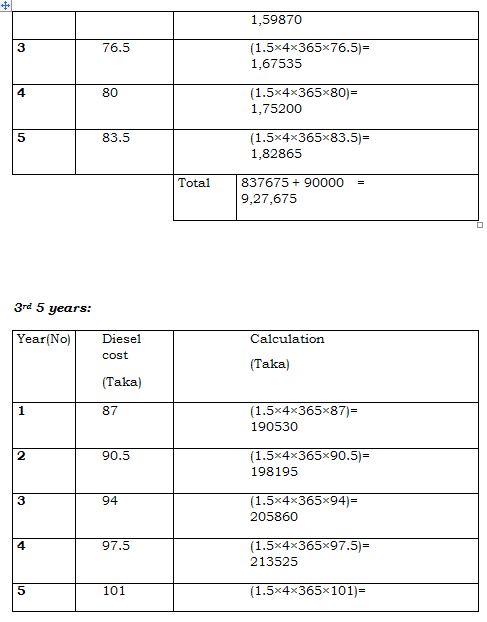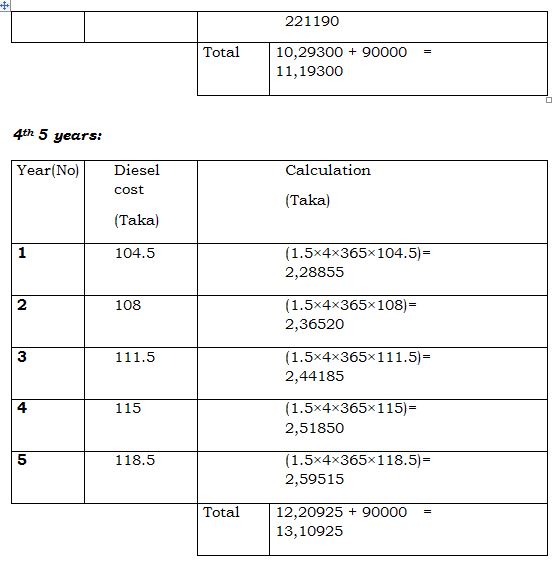
In the chapter two, the potential of the solar home system is discussed briefly. To make a proper impact evaluation of SHS, potential analysis is very much important. Bangladesh is situated in such a region that solar energy is very much available. For this reason solar home system can be justified as proper alternative to the power generation option. This chapter also provides the solar radiation data which can be used to compare the potential over other country. A brief discussion about the Partner Organization (PO) is available in chapter three. PO’s have the authority of distributing and installing SHS in Bangladesh. Knowing the PO’s activity is very
Chapter six is about the cost comparison study between SHS and diesel generator. This is a unique research segment in this report. As we know govt. of Bangladesh is giving the subsidy for the diesel for its power generation impact. But we know that diesel based generator is so much costly and it is also a threat for environment. Again sometimes it is very hard to get diesel in the rural areas. So a better alternative is very much needed which is available and cost effective. This chapter it will prove that SHS is the better alternative over diesel generator. Detail calculation is also found in this chapter. Chapter seven is the conclusion part. In this part an effort is made to summarize the impact and future possibilities. There are some suggestion is provided after analyzing the whole report which can be very much effective for the future research work.
Solar Home System Potential In Bangladesh
Bangladesh is situated between20.30-20.38 degrees north latitude and 88.04-92.44 degrees east which is an ideal area for solar energy. Utilization of solar energy potential is very important for the impact analysis of SHS in our country. Daily average solar radiation varies between 4-6.5 KWh per square meter [8]. We can get maximum amount of radiation on March-April and minimum from December –January. According to recent studies, yearly average insolation availability in Dhaka is 1.73MWh per square meter on a horizontal surface and 1.86MWh per square meter on a tilted surface. Again the annual amount of radiation is varies from 1840-1575 KWh/m2 which is 50-100% more than the Europe. Taking an average solar radiation of 1900 KWh per square meter, total annual solar radiation in Bangladesh is equivalent to 1010*1018 J. Present total yearly consumption of energy is about 700* 1018 J. It shows that even if 0.07% of the incident radiation can be utilized, total requirement of our energy can be met [8]. At present energy utilization in Bangladesh is about 0.15 Watt/sq. meter land area, whereas the availability is above 208 Watt/sq. This shows the enormity of the potentiality of SHS in Bangladesh by using this huge solar energy [9]. What fraction of it can be used for our use will depend on the availability of the technologies suited to local conditions [10].

Table1: Here is the monthly average hourly GHI* (Wh/m2) data, 2003-2005, Bangladesh [9]

*Global Horizontal Irradiance
(Source: SWERA Project, RERC, University of Dhaka, Bangladesh)
Top Partner Organization (PO) In Bangladesh
 FINANCING SHS:
FINANCING SHS:
Grameen Shakti has developed four different credit schemes to make the solar home systems affordable. Customers pay different proportions of down-payment and monthly installment according to their circumstances, supported by low-interest loans that Grameen Shakti receives from the Dutch Stichting Gilles Foundation and from the World Bank through the Bangladesh Ministry of Finance’s Infrastructure Development Company Limited (IDCOL). Four different schemes are [10]:
- The user has to pay 15% of the total price as down payment. The remaining 85% of the total cost is to be repaid within 36 months with 6% (flat rate) service charges.
- The customer has to pay 25% of the total price as down payment. The remaining 75% of the cost is to be repaid within 24 months with 4% (flat rate) service charge.
- Micro-utility: The customer has to pay 10% of the total price as down payment. The remaining 90% of the loan amount is to be repaid by 42 checques. There is no service charge.
- 4% discount is allowed on printed price in case of cash purchase [10].
- Demonstrations, door to door visits.
- Meeting with village leaders, distributing brochures.
- Science fairs at the local level Buyback system.
- Workshops for policy makers at national level [10].
BRAC Solar: THE COMPANY AND SHS: BRAC is one of the largest NGO in the world & it is working for environmental issues for long time. BRAC Green Enterprises is a combination of three enterprises, which work under an umbrella to provide green solutions for the corporate urban market: BRAC Solar Enterprise works for power solutions, BRAC Nursery for landscaping and plant rental, and BRAC Recycled Paper for office stationeries. Together, this group of green enterprises is engaged in the production of environment-friendly products, and are consequently aiding in the social uprising of green initiatives in both rural and urban communities [16].
BRAC Solar Enterprise started its journey towards rural electrification through solar home systems in 1998, in collaboration with the Infrastructure Development Company Ltd. An integrated and multipurpose program, its projects spread across the country in a wide variety of settings including households, BRAC and other NGO offices, training centers, schools, health clinics, cyclone shelters, a weather monitoring station, a government rest house and income generating centers such as carpentry, tailoring shops, cloth dyeing and printing shops, leather workshops, restaurants and grocery shops. The project operated with an aim to change the overall socio-economic status of rural people of the project areas by creating new jobs, increasing the education hours and helping the poor to carry out income generating activities [16].

Table2: Payment types.
One way is by providing training on the basic maintenance and safety of SHS. RSF takes a solar demonstration kit around villages along with the POs, to show people the benefits of owning an SHS. RSF also carries out servicing and repairs on behalf of the POs [18]. Solar Home System Components and Their Testing Procedure (PV module and Battery testing) :
- Global irradiance on the plane of incidence, G > 600 W.m-2
- Diffuse fraction of global horizontal irradiance, D(0)/G(0)<0.2in a clear day.
Wind Speed: should be higher than 1 m.s-1 which is equivalent to a gentle breeze.
- Co-planar position, without obstacles hindering thermal dissipation.
- Orientation should be towards the equator.
- Tilt is an angle leading to incident angles direct solar irradiance below 40º. [For example: solar zenith angle at noon or, generally speaking, tilt angle equal to|φ|(local latitude) in autumn-winter, and equal to max{|φ|-20º, 0} in spring- summer.]
- Should be cleaned before with soap and clean cloth.
- Modules should expose outdoor before testing to make assures that modules are at thermal equilibrium.
Measurements:
- Should be performed within 1 hour from solar noon.
- Total duration for the three (V, I) points and their corresponding operation conditions must be less than 5 minutes. In this way, no major variations of operation conditions can be achieved. (For this same reason, no measurements should be done in days with strong wind or passing clouds)[19].
After having the PV module in the hand, there are some visual inspections which should be done. By having visual inspections outer damage and others things can be identified. Table I lists the different aspects to be inspected, as well as defects leading to a PV module rejection.


- Irradiance measurement
- Cell temperature measurement
STEPS: Irradiance measurement: The method is based on the linear relation between ISC and G, from which the following expression results:
G (W m – 2) =1000*(Isc/I* c)
Where subscript “S” added denotes as the sensor-module. This expression involves a slight overestimation, since no second-order effects (TC influence) are considered. Nevertheless, the use of the proposed expression in procedure 3 has the effect of cancelling such error. According with figure 1 and eq. (above), the voltage measurement in the calibrated shunt (precision resistor) allows calculate the irradiance value [7].

Cell temperature measurement:
Tc = {1/ (Ns,s *βT)}*(Voc,s- V*oc,s)+ 25°C
βT=2.3 mV/°C and NS,S is the number of series-connected solar cells in the sensor-module. This expression involves a slight overestimation (rapidly decreasing with increasing G). Nevertheless, as it is the case with irradiance measurements, the use of the proposed expression in procedure 4 has the effect of cancelling such errors. Figure 2 shows the assembly required for the use of the proposed method [19].

ELECTRICAL PARAMETERS TEST AND EXTRAPOLATION AT STC:
- Characterization of the short-circuit current parameter.
- Characterization of the open-circuit voltage parameter.
- Characterization of the Maximum Power.
- Fill Factor determination
STEPS: Characterization of the short-circuit current parameter: Measure one day ISC values of the module under test by irradiance measurement procedure. Single values must be individually extrapolated to STC using the following expression:
sc =1000*(Isc/ G (W m – 2))
Measurements periodicity should be at least 1 hour. The desired parameter ISC* is the average value of the individual extrapolations [19].
Characterization of the open-circuit voltage parameter: Measure during one day VOC values of the module under test, together with TC estimates from the cell temperature measurement. Single values must be individually extrapolated to STC by means of the following expression:
V*oc= Voc-( Ns/ Ns,s)* (Voc,s- V*oc,s)
Measurements periodicity should be at least 1 hour. The desired parameter V*OC is the average value of the individual extrapolations [19].
Characterization of the Maximum Power: It is based on the measurement of three single points of the module I-V curve, which are to be used for the determination of the maximum power at STC, PM*, once the fill factor, FF*, has been calculated [19]:
PM*= (I* c ) ( V*oc) (FF*)

Fill Factor determination:
For the practical determination of FF in a PV module, the following equations are proposed:
FF = FFo . (1 – rs)
Where FFo is the ideal fill factor (no resistive effects):
FFo = {voc – ln (v oc + 0.72)/ (voc + 1)}
Voc is the normalized open-circuit voltage of each solar cell (average):
Voc= VOC /NS . Vt
Where Vt is the thermal voltage. rs is the normalized series resistance of each solar cell (average):
rs = Rs(Isc/Voc)
These parameters enable to calculate directly the maximum power point (VM, IM):
Vm=Voc {1-(b/Voc). ln a- rs. (1-a-b) }
Im= Isc(1-a-b)
Being a and b two intermediate parameters:
a= voc+1-2voc rs b= a/(1+a)
All these equations can be used for any operation conditions, given the following compliance: voc > 15 and rs < 0.4. This covers real operation for most Si solar cells. Accuracy in the calculation of the maximum power using above equations is better than 1%. The series resistance, assumed independent of operation conditions, can be calculated using above equation and three (V,I) points [19]:
Rs =Rs =[Ns.Vt(25°C) ln(1-I /I sc)+V oc-V ]/I
Current measurements are extrapolated as the short-circuit current:
I*=I*+(I* -Isc)
Voltage measurements are extrapolated as the open-circuit voltage:
V*=V*+(V*oc-Voc)
Instrumentation:

Instrumentation comprises the following elements:
- Voltmeter, for the PV module voltage measurements.
- Ammeter for the module current measurements or, alternatively, a combination of shunt + voltmeter.
- Battery, for fixing a certain operation voltage at the PV module. If it is a conventional (36 series-connected) module, a 12-Volts battery will be used. For other types of modules (e.g., low-voltage, based on 12 series-connected assemblies), combination of 2-Volts battery vases can be used (or even the battery can be disregarded).
- Potentiometer (variable resistor), for a more precise adjustment of the module operation voltage. It should be noted that this adjustment, because of inherent limitations of the potentiometer, cannot be as fine as would be desired. This component must be able to stand the maximum power of the PV module under test.
- Irradiance sensor-module: calibrated module in ISC* parameter.
- Cell temperature sensor-module: calibrated module in VOC* parameter [19].
Battery:
Batteries have been identified as the most costly component during the SHS lifetime. Commonly, lead-acid batteries are used. Battery lifetime depends strongly on battery type, correct sizing of the SHS, local climate and proper operational management for example, charge regulation algorithms and maintenance procedures [5]. The most important feature of battery operation in SHS is cycling. During the daily cycle, the battery is charged over the day and discharge over the night-time load. Superimposed onto the daily cycle is the seasonal cycle, which is associated with periods of reduced radiation ability. This together with other operating parameter (ambient temperature, current voltage etc.), affects the battery life and maintenance requirements [6]. In order to maximize the lifetime of the lead-acid batteries, the following operation conditions must be avoided:
- High voltage during charging(to prevent corrosion and loss of water)
- Low voltage during discharging. (corrosion)
- Deep discharge(sulphation, growth of dentrites )
- Extended periods without full charging(sulphation)
- High battery temperature (all aging process are accelerated )
- Stratification of the electrolyte(sulphation)
- Very low charge current(sulphation)[20]

- Classical
- Modified
- Low maintenance[20]
“Classical SLI’’ batteries use lead grids alloyed with antimony and require periodic topping up with water.[20] Again certain condition must be met in order to categorized as “modified SLI” , as follows :
- The thickness of each plate must exceed 2mm.
- The amount of electrode must exceed 1.15 per 100 Ah of 20- hour nominal capacity and per cell.
- The separator must be made of microporous polyethylene.
- The density of electrolyte must not exceed 1.25 g/cl. [20]
Above requirements should be checked directly in terms of battery testing. Again if the battery is delivered dry-charged it should be filled with electrolyte of a density lower than 1.25g/cl. “Low –maintenance” SLI batteries are sometimes marketed as a maintenance free batteries, often grid containing calcium alloys. The calcium increases the voltage at which gassing begins but reduces the cohesion of the active material to the grids. Hence, it cut down the loss of water but also reduces the cycle life. Such batteries are particularly vulnerable to damage to damage from deep discharge. In addition they are also liable to be damaged by high temperature variations. So, it is recommended not to use in the hot countries. [20] The 20-hour nominal battery capacity in amp-hours (measured at 20 W and up to a voltage of 1.8 V/cell) should not exceed CR times the PV generator short-circuit current in amps (measured at Standard Test Conditions) [20]. CR values are proposed for each type of battery in the table below:

The maximum depth of discharge, PDMAX, (referred to as the 20- hour nominal battery capacity) should not exceed the values proposed in the table below:


PROCEDURES OF TESTING: INITIAL CAPACITY: This starts just after filling the battery with correct electrolyte density. It determines the initial state of formation of the plate.
STEPS: Now when the battery is filled, discharge the battery down to 10.8V at an I20 rate, or close. This discharging is done through a load with the adequate ohmic resistance (this load can be a lamp) to take the desired current from the battery. Measure the supplied Ah (norm CB5). The pass criteria establish a minimum capacity of 95% of the nominal capacity. Batteries with low initial capacity need a strong charge before the installation, which should be clearly indicated in the technical information by the manufacturer [19].
INSTRUMENTATION: Current source, lamp, calibrated shunt resister, multimeter.
STABILISED CAPACITY AND CYCLING: The objective of this test is, first, to obtain the real stabilized storage capacity of the battery after some charge and discharge cycles, which can be compared with manufacturer data. Second, from this test can also be determined the voltage evolution of the battery with its state of charge, a crucial point for the regulation functions of the charge controller [19].
STEPS: After the first discharge, the battery is charged completely by a current source at 14.4V for more than 24 hours until the input current remains constant, in order to assure an absolute formation of the plates [7]. Now, constant I20 rate, or close, discharge and charge cycles are performed until the battery capacity reaches a stabilized value, while voltage VB and current IB values are measured. The measuring time steps should be 60 seconds if an automatic data acquisition system is utilized, but 10 or 15 minutes if manually data measuring is done. The battery capacity and voltage evolution with state of charge can be obtained from this test (norms CB3, CB5 and RB2) [19]. The capacity corrections to discharge rate observe the following expression:

Iga (mA / 100 A.h) = Igo. exp [CU. (Vvaso – 2.23) + CT .(T – 20)]
Where parameters are Igo, CU y CT obtained by adjusting the experimental results.

INSTRUMENTATION: Current source, multimeter. The following information and specifications must be available from the battery manufacturer, supplier or recognized test Laboratory:
- Make, type, nominal voltage and nominal capacity.
- Capacity at 10-hour discharge rate (at specified temperatures).
- Electrode type and type of electrolyte.
- Specific gravity ranges for the electrolyte (for flooded batteries).
- Graphical information on charge and discharge characteristics, at different current rates and specified temperatures.
- Graphical information on cycle life versus depth of discharge (at specified temperatures)
- Information on any particular regulation requirements for optimal cycling in a PV environment[20].
In general, the data must be sufficient to establish the suitable method of battery regulation and suitable set points. Additionally, the tenderer shall submit information in respect of:
- Battery safety requirements.
- Battery maintenance requirements.
- Battery replacement requirements [20].
BATTERY PROTECTION: Batteries shall be protected from the weather and installed in boxes or suitable enclosures which fulfill the following requirements:
- · Access to the terminals and electrolyte shall be restricted to authorized and responsible persons only. Batteries shall be protected from access by children. However, the batteries shall be accessible for inspection by authorized persons.
- · The terminals shall be protected from accidental short-circuiting from a tool being dropped across the terminals, for example.
- · There shall be sufficient ventilation for hydrogen to escape. Hydrogen shall not be routed to any location where there is a danger of sparks or flames.
- · There shall be at least 20 mm free space between the batteries and the walls and top of the battery box.
- · The battery box or enclosure shall be made of suitable, durable and acid-resistant materials.
- · A permanent notice shall be fixed to a battery box or suitably placed at a battery enclosure as a warning of the hazard from a release of gases, the danger of explosion, and that smoking or flames should be prohibited[20].
House Hold And PO’s Survey Result:Impact Analysis:
House Hold Report:
Background:
We have conducted our survey on different household having SHS in their home. Different types of questions regarding SHS were asked to them. Based on this survey we have figured out the summery of the impact of SHS in Bangladesh.
Methodology:
Several researches have been done to evaluate the solar home system condition in Bangladesh. But the main focus of our research is to identify the proper social improvement of our country though SHS. That’s way our questionnaires were patterned differently so that it can reflect the impact of SHS. We conduct our survey on the Gazipur (Kapasia) area which is near to the Dhaka city and our data base survey will definitely define the condition of the socio- economic scenario of those areas as a symbol of rural area of our country. We have made our interview with the household owner and some small grocery owner. We have also made a huge study on the previous research work, which helped us to make an effective summery on our research work. Our next section will discuss briefly about our research work and the effective results.
Household Survey:
We have conducted our survey on the 25 household and other 5 grocery shop. All the households are dominated the male member of the family. The income of those families was not so high. We found that there are more than 50 percent families whom are incoming lower than 7 thousands money per month and only a few household having more than 10 thousands taka per month.
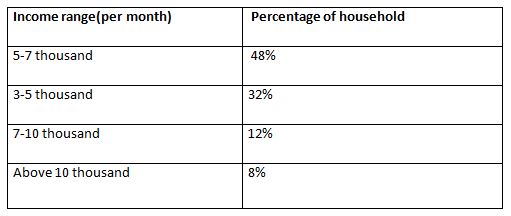
Fig9: range of income per month.
This chart says that 48% of the households are low income family. So this is very hard to them to pay the total amount installation money. Here comes the feasibility of the monthly installment with low interest. More people go for the monthly installment rather than bearing total installment cost. From our data we can say that about 80% household install SHS by monthly installment scheme. Usually different types of panel are offered by the Pos. But the most popular is 50Wp solar panel. 50 Wp solar home systems were most common in the study area which can run three lamps and one black and white TV system. Larger capacity systems (75Wp) were used by comparatively larger family (higher income group) it was also a popular size [15]. But still larger groups of people are using 50 Wp panel because of their cheaper prize and lower installation program. Here is the top two PO’s 50 Wp scheme:

Table4: 50 Wp system with load and price.
From the table we can the price of 50Wp solar panel price of top two PO’s. Now there is our one of the researcher data of most using SHS system.

From the survey report that we get from the rural areas we summarize a report in which it can be realized that what amount of load they are actually used. The result indicates that there are some common loads which are used in the household. They are like light, mobile charger, fan, radio, TV (B/W), Refrigerator etc. But from the survey it seems that about most of the family use light and mobile charger. Not all the families are usually go for the fan and radio but lots of families are now having fans. Near about 50% families are having at least B/W TV in their home. Refrigerator is not so popular yet. But the number of families who are using refrigerator is also increasing with the increase of their family condition. From the government report it can be find that the poverty graph is decaying from the last 15 years. An increasing data of electronic materials since last 10 years is also included here.
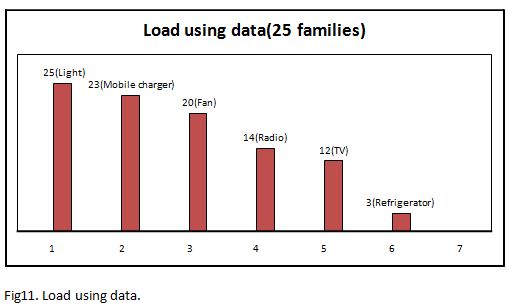
Table5: Here is the data of increased number of electronic materials in our rural area in last 10 years
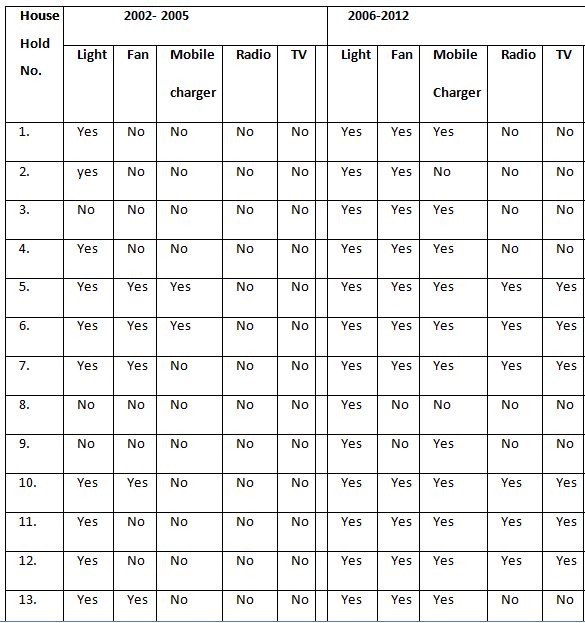
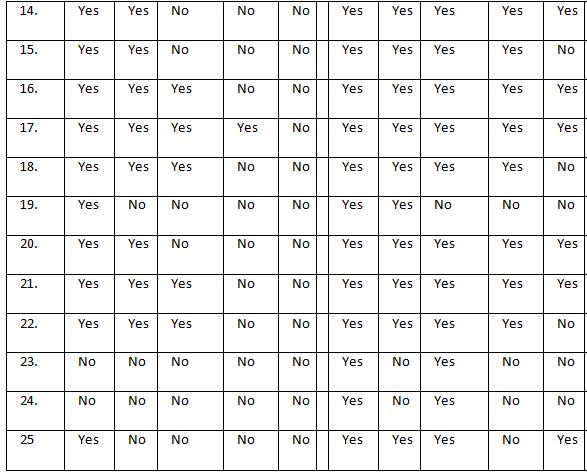
All those data includes the rural electric load using situation of our country. Actually in the rural area all those loads are not used constantly. There are some particular time of using all those loads and all those are using at a time. We have also focused on time of using loads. After conducting the survey we make a summary of time table of using load.
Table6: The Period of Daily Energy Consumption for Lighting and Entertainment
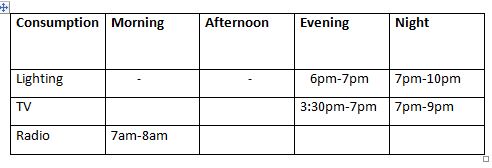
Table7: Daily Typical Energy Requirement for Lighting and Entertainment [15]

From Table we can see that the average daily electricity requirement for one house hold is 156 Wh.
Having realization of total background of the electric system in the rural area, now it’s time to have a proper comprehension on the regular problems of the households. Though the poverty line our country is decaying day by day but still we are below poverty line and per capita income our country is very low. People living in the rural area still have to survive for their food and cloths. Those are the real scenario of our country people. So without any doubt it can be dogged that financial problem is the foremost problem in our country. But still electricity problem also take the crucial place in rural areas people life. For this reason, problem identifying survey took a vital place in our report.

We can see the actual phenomena of our rural areas by analyzing this fig. So Solar Home System (SHS) can play an obvious roll where there no grid electricity is connected. SHS can provide electricity with a low cost and without distorting the environment. We conduct a survey that how SHS can contribute an impact in the rural regular life.
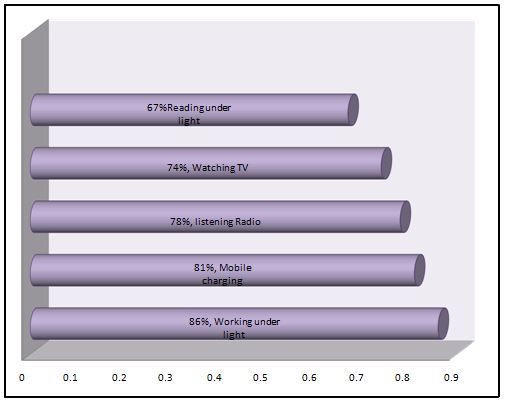
Fig13: Electricity consuming activity through household [21].
Here we can see that some of the regular activities with the help of SHS. So it is demonstrated that SHS has our rural life more active and easier than before, when there was no electricity. Gradually SHS is having priority to the rural people. But still because of high installation price many people are not that much interested to have SHS in their home. Again some people are not enough satisfied with the service of the SHS organization. But overall result declares the maximum numbers of satisfaction with SHS service who are using this. For utilizing better impact we have also conduct a survey to those household who are not using the SHS along with 25 household.
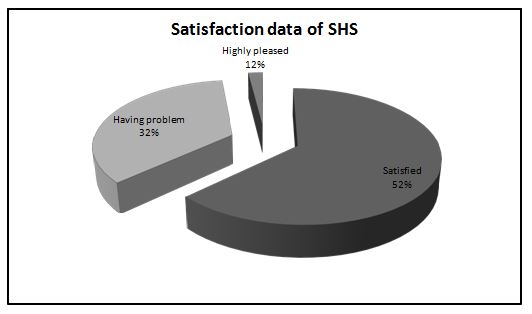 Fig14. Comparison of satisfaction data.
Fig14. Comparison of satisfaction data.
If we compare this report with the Michael Blunck report 2006 [21] we may have a clear concept that how SHS is gradually becoming a popular name to our rural people. Let’s have an overview of Blunck’s satisfaction data 2006.

Here we can see positive improvement of SHS within 6 years. So, we can say that people are benefiting much more from the SHS. Only that’s way we can see an improvement of 35 %( 2006) to 52% in our survey. Now our target is to find the reason why people are getting more interested with SHS. So our next conducted data is based on the reasons behind the public popularity towards SHS. In the survey we have asked people about the socio-economic impact of the SHS. Our motive was to identify the changes that SHS brought to them. Lots of points were in survey that brings changes in household regular life. People get better entertainment facilities with the help of SHS. That entertainment brings change in rural people life. Rather than doing gossiping ideally people prefer to see many TV shows and gaining some knowledge. It also helps people to keep steps with the modern world and knowing the present world events. Having light facilities in the home children can have more time to study. Farmer can work more time in the field. Better lighting facilities have also changed the routine of the household girls. Now they do not depend only the sunlight top do their household chores. In the daily communication is not a big deal to the rural areas people. With the help of mobile and better lighting facilities they can move easily anywhere needed. Actually they feel more secured life of their own. These all are the positive impact of the SHS in the rural life. Actually in summery we can say that the standard of our rural areas people has increased with the help of SHS.

Figure15: Daily life changing by SHS.
From the figure we can have a clear idea that everyone in the family having benefits through SHS. But our motive was to find the most benefited member by using SHS. The result of our survey defines that the most benefited members are women. Actually they are having lots of activities by using SHS. They are having entertainment at night by watching TV rather than ideal setting. By this they are also learning something and advancing with the world. Some of them are educating themselves by watching TV and hearing radio. Children are also very much benefiting as their activities increases. They are having chance to grow up like town people. Most of all security of the women and children has increased by having SHS.

Fig16: Most benefited member.
In our survey we also asked the battery and charge regulator matter to the household. Because this two components contain short time warranty period. So, people need to change these things after certain amount of time. Each PO’s have their own program to teach people what to do with those damage components. We surveyed 25 families to make it clear that what they do with those damage components. Maximum of them returned the NGO after using but not all. Some of them throw it out which might be very much harmful for the environment [16].

Fig17. Damaging battery issue.
From the above data we surveyed it is clear that SHS is having a clear cut impact in the rural social life. We hope that is impact will bring more positive results furthermore in our country and reduce the pressure on national grid.
PO’s Survey:
We have managed a survey in the Grameen Shakti and asked them a lot of questions related to the SHS. The answers they have provided is very much important for my research work. Based those answers a comparison study between SHS and diesel generator is provided in the next section. Here are the questions and their answers:
1. How many Solar Home Systems (SHS) Unit has been installed and how to identify them?
Answer: About 7 lakes (ongrid+offgride, 2011, GS). Anyone can identify by asking the owner or having a look on the rooftop, where u can see solar panel.
2. What percentage of remote area are getting benefits from your SHS installation?
Answer: We have all already installed 59.45% of total installation & benefiting over 30 lakes of people.
3. What kind of SHS package are you offering?
Answer: 10 packages,
4. Which package is mostly used by the user and why?
Answer: 50 Watt with 80 amp hour (around 20 to 50 percent sell) & 20 Watt with 30 amp battery (around 34% sell) .
5. How many solar hours are there in an average day where the SHS is installed?
Answer: Average sunlight hour in Bangladesh range from 10 to 7 for summer and winter respectively.
6. What should people do in terms of winter or rainy season when usually less solar hour in an average day?
Answer: Actually, at that period people have to depend on the national grid. Because our efficiency decreases when there are less solar hours. But they can also save power for using that period.
7. What are the ac & dc loads used by or given to a user? Answer: Black & white TV, Color TV, light, fan, charging mobile, again some schemes can provide power for operating computer.
8. How do you overcome the limitation of SHS components wiring?
Answer: they could not overcome.
9. What is the reason behind giving a 50watt or 30watt panel with a very high rating battery?
Answer: using 50 watt or 30 watt will provide more backup.
10. How many watts per hour is used by an average family in a typical day or approximately how many hours does a family uses the light and fan?
Answer: about 9 to 12 hours.
11. What complains mostly stated by a user of SHS?
Answer: Mostly stated complain is related to the costing. There are also some complain related to technical site.
12. What steps do you take to overcome those complains?
Answer: As we said before a lots of complain related to costing. So, we are trying to reduce our cost but still we have some limitations. Our technicians are always ready to meet any technical problems. But we think a lot of problems arise because of illiteracy of our people. Lots of people are unable to use properly. It causes less efficiency. But we have some programs to let those people know how SHS can use properly.
13. What are the most technical difficulties that you face while installing SHS in an area?
Answer: most technical difficulties are: condition of the rooftop.
14. What are the technical faults that come out of the SHS packages during the warranty period?
Answer: technical faults are: inverter problems, charge controller problems, permanent battery damages problem due to discharging less rated value.
15. The appliance that runs with a SHS package is mostly run with AC or DC current? If it runs with AC current then what kind of inverter you are giving? Is it made by local market or outside?
Answer: dc, local made square wave inverter.
16. What kind of charge controller given with the SHS package? Is it MPPT or not? Is it made by the local market or outside? How it’s performing?
Answer: not MPPT, yes it is ,made by the local market. Good.
17. What kind of converter you are using for the dc package of solar home system? Is it made by the local market or outside? How it’s performing?
Answer: they use only local made converter, & those are performing good.
18. We know many of remote area’s people are not even accomplished with the Solar Home Systems. So, what types of marketing procedure are you going to take to spread it all over the country?
Answer: Grameen Shakti follow very much disciplined process to promote SHS in the rural areas.
- Demonstrations, door to door visits.
- Meeting with village leaders, distributing brochures.
- Science fairs at the local level
- Buyback system.
- Workshops for policy makers at national level.
19. Do you provide service centre for your customers? Do you think it may be an effective process to gain loyalty?
Answer: We have 786 unit offices in all over 64 districts & those are very much important to provide proper services to the customers.
20. Do you think Solar Home Systems can be a signature part to spread primary education and health care opportunity in remote areas? What’s your plan to develop this opportunity? Answer: Yes, SHS can be a signature part to spread primary educations. Actually, still we are providing SHS in many primary schools on rural areas. Now we are promoting to spread it all over the country.
21. Do you have field level monitoring and verification department? How does it work?
Answer: Yes, our unit offices do the field level monitoring & verification. They also detect the field level problems of SHS & their solutions.
22. How come your SHS project creates employment locally?
Answer: Grameen Shakti has always sought to involve the local community in the planning, implementation and maintenance of solar home systems and has started a network of technology centers. The technology centers are managed mainly by women engineers, who train women as solar technicians. The women are equipped with tools to service and repair the systems in their areas, and to manufacture solar home system accessories.
23. What is your current promotion rate per month?
Answer: Average rate of 4000 SHS per month.
24. The rise of world market prices of SHS components has caused higher prices for system & the customers are irritated by price changes. In this case what should you do keep prices in the customers ability?
Answer: we can improve our technical side & make components of our own to keep prizes in the limit.
25. Solar energy technologies still remain a costly alternative to the use of readily available fossil fuel technologies. So, what is your technological future plan to reduce this cost & make this cheaper alternative to the people?
Answer: It still remains costly because of the components prize, so the main solution is to make them in our local market.
26. Microcredit concept has both positive & negative effect. Do you think it can be a revolutionary move in SHS? Or, it can ruin the interest of customer to get familiar with SHS?
Answer: We think it has a positive impact. Actually, our rural areas people are not capable of giving all the money together. So, microcredit is a easy solution for them.
27. What irradiance parameter is usually used to measure solar insolation? (DNI – Direct Normal Incidence, DIF – Diffuse Horizontal Irradiance, etc.)
Answer: they not yet think about that.
28. What instrument is used to measure the solar insolation at the site of PV installation?
Answer: not applicable.
29. During the summer time the solar panel should be tilt 15+ degree with the latitude an during winter it is 15- degree with the latitude? Does user follow this convention? If they doesn’t then will a one day training of this things be helpful or not?
Answer: they do not have the one day training procedure.
30. Is it feasible to install single axis or dual axis tracking systems (manual) for the PV modules?
Answer: not applicable.
31. What is the percentage increase in total cost of the SHS if a tracking system (manual) is included?
Answer: not applicable.
32. What is the efficiency of the inverter used in the SHS?
Answer: 50 percent.
33. PV modules are usually 14 to 18% efficient in converting sunlight to electricity. So after including inverter and charge controller inefficiencies, what is the net efficiency of the SHS?
Answer: 13 percent.
34. Do you have research unit for improvement of overall efficiency of the system and ancillaries? What kind of work they are doing now?
Answer: Research unit is very much efficient for our further work. Actually they are accelerating our work by their new ideas. Still we are working for our costing adjustment.
35. What methods can be employed to hybridise/combine the SHS with other power production methods so that electricity can be supplied round the clock after sunset?
Answer: introducing on grid SHS enable them to supply round the clock.
36. If, for example, a 200W SHS is going to be installed, which is the better option: two 100Wp PV modules or four
50Wp PV modules? What is the justification behind the better choice?
Answer: two 100 W. because they don’t have micro inverter technology.
37. Is it possible to connect the SHS to the electricity grid so that excess power produced by the panels can be sold for a feed in tariff by the consumer? If they can be connected, then what are the extra components required and by how much will they increase the total cost of the SHS?
Answer: they don’t have. Inverter is required dual switching mechanism, it is expensive.
38. How the PV systems are to be utilized in order to achieve sustainable development in rural households?
Answer: as we know most of our rural areas people are illiterate. So, we have to gain their attention and make them realize the system. Our promotion part may keep a vital rule in that case.
39. Have you investigated the other viable renewable energy sources in the areas and ascertained their feasibility in a smaller scale?
Answer: those are more costly than SHS.
40. Many battery types can pose serious problems when disposed as municipal waste; their toxic constituent can be released into the environment causing damaging health effect. So what are your possible steps to reduce this kind of environmental damage?
Answer: we can make a effective group to collect them & recycle them to use again part to part.
41. Reduction of toxicity of battery may be solution of that damage. Again it is mainly issue to be dealt with by battery manufacturers. Are you concern to the reduction of toxicity issue?
Answer: yes, now we are concerning more to recycle our battery parts. Now it is an environmental issue.
42. Extend the life time of battery may be a solution of it. What kind of battery may be used to extend life time?
Answer: solar deep cycle battery, but expensive.
43. Now the advance world is thinking about the battery recycling. What do you think about it?
Answer: as we said before, yes we are now thinking our battery recycling process.
44. In this process batteries need to be collected. Who do you manage to collect those batteries from the rural areas?
Answer: we are thinking about the new department of recycling battery. We are thinking of having sub offices in every district that can manage to gather damaged battery.
45. Now we can see the growing amount of SHS demand. By this assumption we can calculate the huge amount of using batteries in the future. It will be a hazard for environment if still not taking any plan to reduce that. My question is, are you really thinking ahead for that? As though it is totally scientific matter, how you going to aware rural people in which maximum number of them are illiterate?
Answer: we have to increase our field level training. If our field level staffs are properly taught then they can trainee rural illiterate people in their own way. Than the things will go in a chain way and the rural people can get those things gradually.
Cost Comparison : Study between SHS and Diesel Generator
Background:
Access to electricity is one of the major factors that impinge on socio-economic maturity of a country. At present Bangladesh is distressing from an acute electricity problem. Around 65% of people having lack access of electricity and majority of them are living in village. Among them about 44% are living below poverty line. So, energy supply in Bangladesh poses great challenges [22].In 2010, the per capital electricity production in Bangladesh was 236KWh. At this time the maximum production was 4,606
MW, disseminated to 2.07 million consuming units (households, business etc.). The generated power was incapable to assemble the demand, leading to a load shedding up to maximum 1500MW. In contrast to this, the demand estimated in the year was 6454
MW, compare to a generation aptitude of 5271 MW. This data comprises only the grid covered areas, without considering the localities in our country which do not receive grid electricity [2]. Actually this statistics indicate that the demand in the grid connected areas alone far away from the production capacity, not to state off grid locality, where the greatest population lives. In this situation Renewable energy technology can be a smart effort to solve this problem by harnessing energy the country’s free- flowing renewable such as sun shine, biomass, wind, tidal current, waterfalls or river currents, sea waves.
For the remote places and the remote island, the panorama of supplying grid electricity is near about impossible within foreseeable future. In absence of grid electricity, using of diesel generator to supply electricity is often proposed as an alternative. Actually using generators is not an effective solution. Using diesel generators has its own set of problems. Generators themselves are quite expensive. So producing electricity by generator is very costly. Even if some household can afford to buy and run this, lack of fuel supply often limit the use of generator [3]. Biomass might be a good alternative source of energy. But it is becoming more expensive and scarce due to high demand. Electricity supply is often erratic due to inadequate power generation capacities [4]. Under these circumstances, Solar Home System (SHS) can be an appropriate alternative to provide electricity. Providentially, Bangladesh is endowed with copious supply of solar energy due to its geographical location. Annual amount of radiation varies from
1840 to 1575 kwh/m2 which is 50-100% higher than Europe [8].
DIESEL GENERATOR COST: 20 YEARS CASE ASSUMTION:
Total running cost: 7, 36050+9, 27,675+11, 19300+13, 10925 = 40, 93,950 Taka
Now,
Maintenance cost:
1 room: 2000 taka/ month (house rent is a subject to increase in next 20 years. So we take the average one)
Calculation for 20 years: (2000×12×20) = 4, 80,000 taka
Again two people for maintenance = 2×4000 = 8000 per month Calculation for 20 years: (8000×12×20) = 1, 92, 0000 taka Total: 4, 80,000 taka+ 1, 92, 0000 taka= 24, 00000 Taka
Total Amount for Diesel Generator: 40, 93,950 Taka +24, 00000
Taka = 64, 93, 950 Taka.
SHS COST: 20 YEARS CASE ASSUMTION:
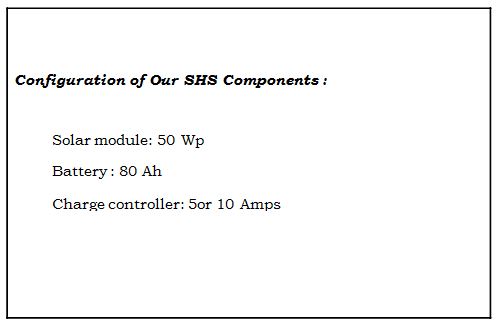
For 80 house hold we need 80, 50 Wp SHS.
Each 50 Wp SHS (including Battery, Charge controller, 4,6watt lamp, switch, switch board, installation and other accessories) costs
26,800 taka (GS).
Total installation cost for 20 years: (26,800*80) = 21, 44,000 Taka
Running cost:
Solar module is warranty for 20 years. So we do need to change it. Battery warranty is 5 years. In the first installation battery cost is
included. So the cost of changing the battery in 20 years is:
80+80+80=240
240*10000= 24, 00000 taka (10,000 for each battery) Now, charge regulator is warranty for 3 years.
In first installation Charge regulator cost is included. So the cost of changing the charge regulator in 20 years is: Approximately 6 charge regulator for each family.
80*6= 480-80(1st installation) =400
400* 1000=4, 00000 taka
Total cost in 20 years =21, 44,000 Taka+24, 00000 taka+4, 00000 taka
= 49, 44000 Taka.
Now, for comparing with the Diesel generator if we deduced the amount for providing light, switch, switch board, installation cost (included in 1st installation) which is not included in diesel generator, the amount will:
(49, 44000-81,600) Taka= 48, 62,400 Taka [(4*80) + (10*10) + (200*2) +200= 1020 [ per household]
SO, Diesel Generator will cost (64, 93, 950 Taka-48, 62,400 Taka) =16, 31,550 Taka more in compare with SHS!!!
Here it is justified that SHS is the better alternative over Diesel generator.
Conclusion : Future Focus and Suggestions
In our above discussion we have tried to make an overall field assessment of the technical aspects of the SHS packages offered by different Pos. From the data of the different packages of SHS Pos, we make a comparison about their efficiency, cost, sizing & some other point of view. Talking about the cost which is still very much high from the affordable range of the local area people we can realize the proper view of SHS. In the short word we can say the growing rate of SHS is around the middle class family & the poorest are still unable to afford it. Again Pos are also trying to reduce their cost but the reality is they have also some limitations & they also have to run their market policy [23]. One thing we can suggest to Pos to increase their research & development sector for having more new ideas. Some strategies could include:
- Offer small system, so that initial investment amount is reduced.
- Cross subsidies may make SHS more accessible to the poor people.
- Installing SHS in school, college, market may increase working hour.
- At present there are limited number of supplier & lack of experience in the solar technology market, resulting the high price of SHS. Again the components are not always available or difficult to source. So it is necessary to increase technology market. Pos all together can make that possible.
Nowadays with the increasing number of SHS installation health issue is adding new dimension. Battery recycling process is compulsory project for each organization to ensure the health and environmental issue. Moreover, at the top end of the organization tree, approved specification, guidelines & technology should be updated frequently to run with modern energy world. Again in the bottom of the organization tree the need to increase their technical training to ensure the proper maintenance service [2]. However there are complains that recently installed SHS performance is certainly worsened from the initial installations. So, thinking the future perspective of the SHS organization should concern about their quality [6]. But still the growing rate of SHS is very impressive & that credit goes to partner organization. So, we can hope that by increasing their service they will put a real impact on the national power generation.
Collected & published by assignment point



